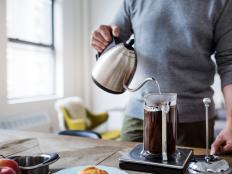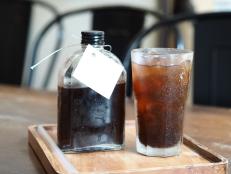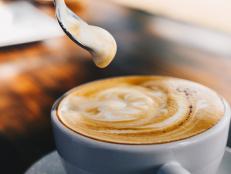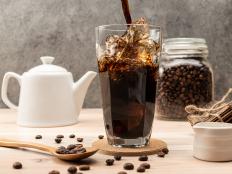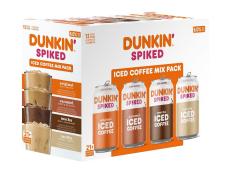How Much Caffeine Is In a Cup of Coffee?
Depending on your joe of choice, the amount can vary quite a bit.
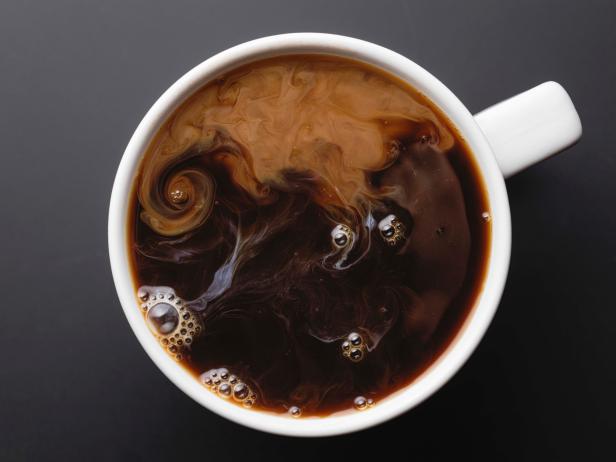
Jonathan Knowles/Getty Images
By Amy Gorin for Food Network Kitchen.
Amy Gorin, MS, RDN, is a plant-based dietitian and owner of Master the Media in Stamford, CT.
For many of us, coffee is the stuff of life. But as powerful as the beverage is, there is such a thing as overdoing it. Here’s what you need to know about how much caffeine is in a cup of coffee.
The recommended daily intake limit for caffeine is 400 milligrams (mg) or less for healthy adults, per the FDA. This typically comes out to about three or four cups of coffee a day—but there are huge variations in serving sizes and types of coffee.
“You'd think coffee and caffeine are simple, but they aren't,” says Elizabeth Barnes, MS, RDN, a non-diet dietitian and owner of Weight Neutral Wellness. “Many factors affect the amount of caffeine in your daily cup. The amount of caffeine in coffee can change based on the type of coffee bean used, the amount of water used, how tightly packed the grounds are, the size of the grind and the length of time the grounds are steeped.” A whole lot more factors exist, too!
Oh, and if you’re pregnant or breastfeeding? “Most research, including a large scientific review done in 2017, continues to indicate that children, pregnant, and breastfeeding women—and people at risk for cardiac arrhythmias—should limit or avoid caffeinated beverages,” says Laura A. Ali, RDN, a culinary nutritionist in Pittsburgh, PA. For example, for women who are pregnant, experts generally advise limiting intake to no more than 200 mg of caffeine per day.

Oscar Wong/Getty Images
How Much Caffeine Is In a Cup of Coffee?
There’s unfortunately no one-and-done answer for this question, as so many factors affect caffeine content. A single cup of coffee can contain up to 485 mg, according to However, the typical eight-ounce serving, per the USDA, contains 95 mg.
Here’s a list of the caffeine content of some other common coffee beverages, from Caffeine Informer. Note that although the technical definition of a cup is eight ounces (oz), many coffee shops serve larger portions.
- Brewed coffee,
- Americano, 12 oz: 154 mg
- Cappuccino, 12 oz, 154 mg
- Latte, 16 oz, 120 mg
- Espresso, 1.5 oz, 77 mg
- Instant coffee, 8 oz, 57 mg (for more info on the caffein in instant coffee, check our story Is Instant Coffee Healthier Than Regular Coffee?.)
- K-Cup coffee, 8 oz, 100 mg
You want to monitor your caffeine intake because too much caffeine can cause certain health problems. Side effects include restlessness, insomnia, headaches, dizziness, dehydration, and anxiety, per MedlinePlus. And drinking coffee can be complicated for people with acid reflux. “Consuming coffee may increase the risk of gastroesophageal reflux disease (GERD), or acid reflux,” says Andrew Akhaphong, MS, RD, a registered dietitian at Mackenthun's Fine Foods. “Coffee may relax the opening of the lower esophagus, causing stomach acid to seep in and triggering GERD symptoms. As well, coffee is considered acidic and may further complicate those symptoms.” The good news for people with GERD: low-acid coffees, such as trucup and Golden Ratio, exist.
Factors that Affect the Amount of Caffeine In a Cup of Coffee
So many factors influence the amount of caffeine in a cup of coffee. A big one: the type of bean your coffee is brewed with. “Contrary to popular belief, dark roast coffee does not have more caffeine than light roast,” says Ali. “It is actually the opposite, as light roast beans contain slightly more caffeine than dark roast.”
Other factors include the method of brewing and the amount of coffee grounds used to make a cup of coffee. “Generally, the longer the water is in contact with the coffee grounds and the finer the grind, the higher the caffeine content,” says Ali. “Drip or brewed coffee will have a moderate amount of caffeine, while pour-over or cold-brew will have more. A boiled coffee that is traditional in some Mediterranean countries has the most caffeine.”
And of course, the serving size of your coffee will affect the caffeine content. Although we often talk about coffee in terms of “cups,” many servings of coffee are 12 or 16 ounces.
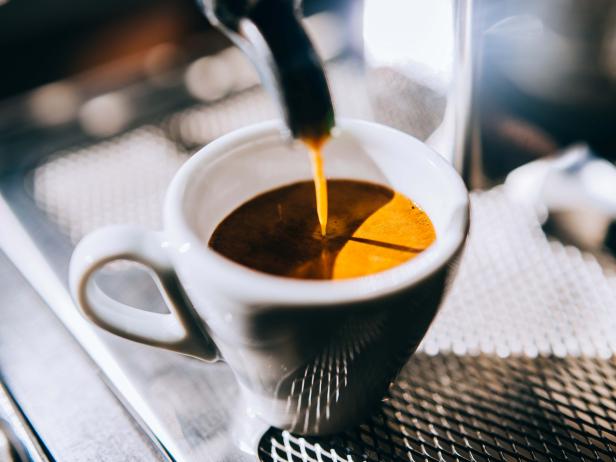
Guido Mieth/Getty Images
How Much Caffeine Is In a Shot of Espresso and an Espresso-Based Drink?
A one-ounce “shot” of espresso typically contains 63 mg caffeine, per the USDA. However, “in popular coffee chains, the standard serving of espresso is two ounces, or a double shot,” says Akhaphong. “Espresso is an Italian preparation of taking a small amount of boiling water under high pressure through finely ground coffee. This results in a liquid highly concentrated in caffeine.”
The really good news about espresso-based drinks? “Generally, it is safer to drink caffeine as an espresso,” says Akhaphong. “Because the serving size is standardized at one or two ounces, the concentration of caffeine is more controlled.”
How Much Caffeine Is In Decaf Coffee?
Surprised to hear that decaf coffee contains caffeine? Well, it does—just not very much. “To classify decaf coffee as such, it is required to have no more than 97 percent of its original caffeine content in the end product,” says Akhaphong. A one cup serving of decaf coffee will usually contain only 2 milligrams of caffeine, per the USDA.
Decaf coffee can be a great go-to for anyone who wants to limit his or her caffeine intake—including women who are pregnant or breastfeeding. And “decaf coffee is a great option for people with caffeine sensitivity,” says Akhaphong. “This includes people who have a history of high heart rates, have struggles with mental health including anxiety, depression, restlessness and insomnia, or gut disorders such as irritable bowel syndrome.” If you are sensitive to caffeine, you will want to cut yourself off from caffeinated beverages—even decaf coffee—several hours before bedtime.
Related Links:
























